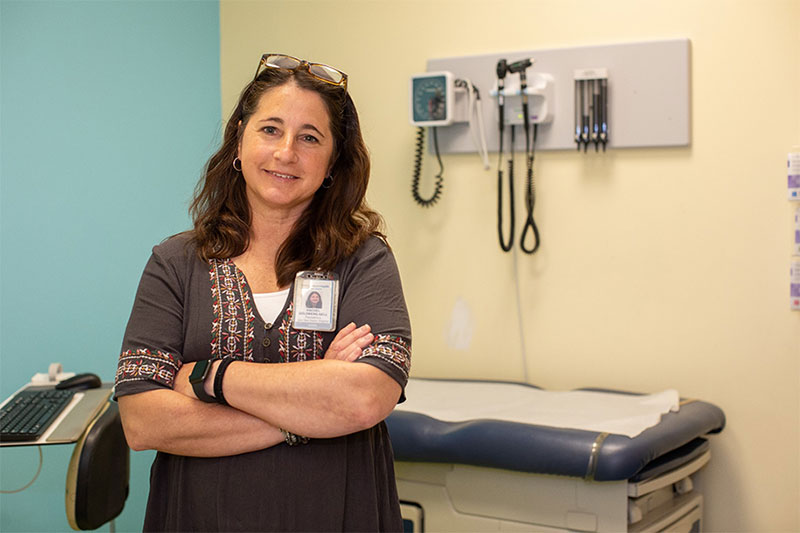
Popular Locations
- Outpatient Surgery - Bridgeport Hospital
- Park Avenue Medical Center
- Primary Care Center - Bridgeport Hospital


Weight is just a number, but obesity is a growing problem affecting children as well as adults. While many factors can contribute to excess weight gain – from unhealthy food choices to a sedentary lifestyle – experts agree that treatment is more important than ever.
“Obesity is a chronic disease, and we have to look at it that way,” said Rachel Goldberg-Gell, APRN, a Yale Medicine advanced practice registered nurse and member of the pediatric weight management team who sees patients at Yale New Haven Children’s Hospital’s Pediatric Specialty Center in Trumbull. “We have to move away from the physical focus of someone’s appearance due to obesity and look at how the disease can affect the heart, the liver, the kidneys and the lungs.”
It is estimated that 1 out of every 5 children and adolescents in the United States currently lives with obesity, a complex disease that increases the risk of health problems, such as heart disease, stroke, diabetes, high blood pressure, arthritis, breathing problems and certain cancers.
Studies indicate that childhood and adolescent obesity has reached epidemic levels in the United States. According to the National Center for Health Statistics, an estimated 19.3 percent of children and adolescents ages 2 – 19 years have obesity, including 6.1 percent who have severe obesity, and another 16.1 percent are overweight as measured by body mass index or BMI. (Learn more about BMI below.)
The American Academy of Pediatrics (AAP) brought more attention to this public health issue when the organization issued its first clinical practice guideline for the evaluation and treatment of children and adolescents with obesity.
The guideline recommends comprehensive obesity treatment, which may include nutrition support, physical activity and behavioral therapy. It also suggests that physicians offer adolescents ages 12 years and older with obesity weight-loss medications (such as Ozempic and Wegovy), and evaluate teens 13 and older with severe obesity for weight-loss surgery.
“With the recent release of the AAP paper, there has been more of a focus on weight management and more aggressive treatment at a younger age,” Goldberg-Gell said. “But I think it’s important to differentiate between weight management for medical purposes versus weight management to get to a certain number.”
While she has seen an uptick in the interest over adolescent bariatric surgery, Goldberg-Gell said traditional measures such as dietary changes and lifestyle modifications remain the starting point for the vast majority of patients. Sometimes, the goal is weight management rather than weight loss.
“Medically, if everything looks normal after a physical exam and evaluation of laboratory results – and the child’s weight is not restricting them – then our focus has to change from significant weight reduction to maintenance, and my role is to make recommendations on healthy eating and lifestyle habits,” Goldberg-Gell said. “Sometimes, it’s a matter of introducing vegetables into the diet.”
Each child is different and the goal on initial assessment is to find out where the patient and the family are in their desire and ability to make necessary changes, she explained.
Goldberg-Gell said she often refers pediatric patients to the Bright Bodies program, which collaborates with pediatric specialists at Yale New Haven Children’s Hospital and offers lifestyle modification and exercise classes to children and adolescents, ages 7 to 16.
Mary Savoye, MS, RD, CD-N, CDE, associate director of the Bright Bodies program and associate director of pediatric obesity at Yale School of Medicine, says the program has successfully helped thousands of children and adolescents across Connecticut and across the country for the past 26 years.
“We’ve been written up in several medical journals, but our original randomized, control trial published in JAMA in 2007, which showed the effectiveness of our healthy lifestyle program on children at risk for type 2 diabetes, was what really put us on the map,” Savoye said.
The Bright Bodies program was also cited in the AAP guideline as being an effective intensive health behavior and lifestyle treatment for childhood obesity, as it delivers 26 contact hours of evidence-based nutrition education, physical activity and behavior-change lessons. What sets the 12-week program apart from others is its non-diet approach coupled with behavior modification.
“We have a hybrid class that meets one night in person and one night virtually,” Savoye said. “We also offer a class that is 100 percent virtual.”
Children and adolescents meet twice per week – once for exercise and once for nutrition education or a behavior modification class. Caregivers also attend nutrition classes and a separate behavior modification class. Children may attend consecutive sessions to reach their weight management goals and further the educational process.
“Every time I meet a child, the first thing I say is, ‘You are beautiful. You are beautiful and perfect. What we want to do is keep you healthy,’” Goldberg-Gell said. “We want children to appreciate their bodies, whatever that weight is – and we want to keep them healthy for the rest of their lives.”
To request an appointment for weight management at the Pediatric Specialty Center in Trumbull, call 877-925-3637 (877-YALE-MDS). On Yale New Haven Children’s Hospital website, learn more about pediatric weight management.
Obesity, which carries a stigma as well potential health concerns, is determined by body mass index (BMI), a measure used to screen the amount of a person’s excess body fat. In children, BMI is age- and sex-specific.
In children and teens of the same age and sex, overweight is defined as a BMI at or above the 85th percentile and below the 95th percentile; obesity is defined as a BMI at or above the 95th percentile; and severe obesity is a BMI at or above 120 percent of the 95th percentile.